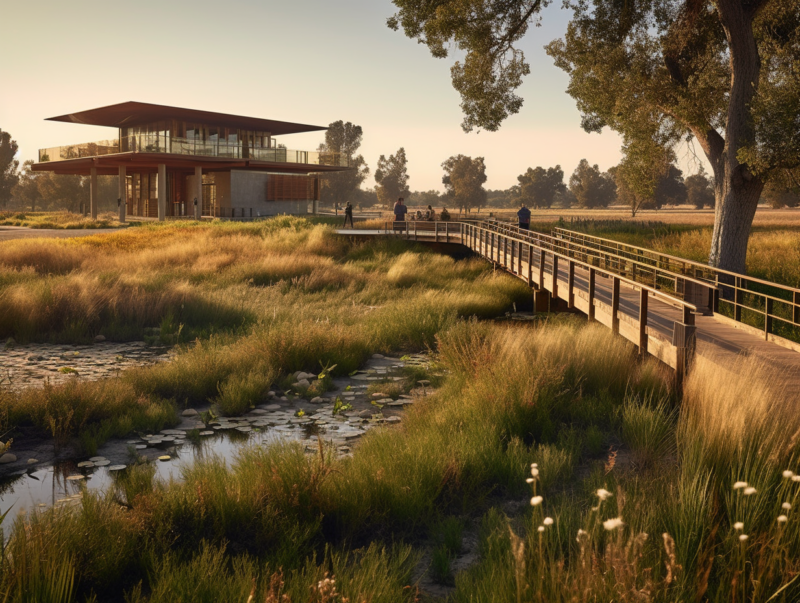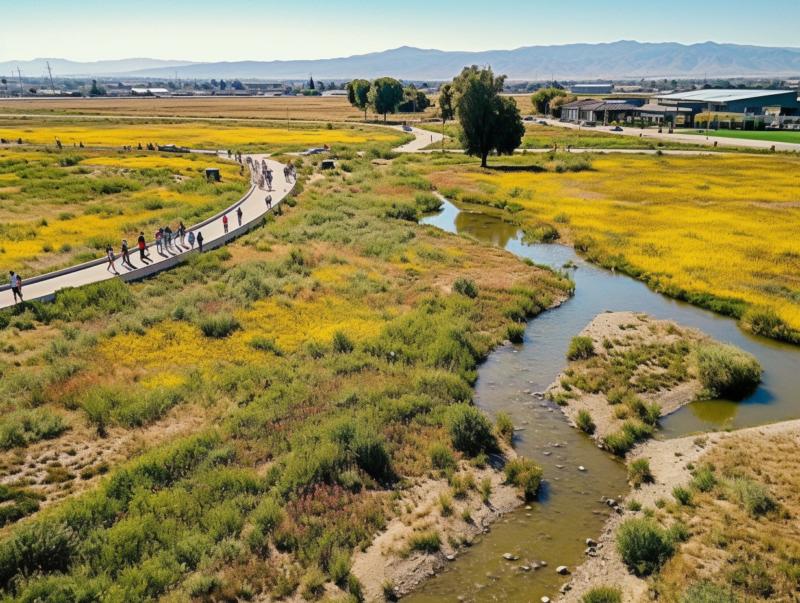
Land Connections – AI in Landscape Architecture Design: Friend or Foe?
Artificial Intelligence (AI) has transcended its role as a mere buzzword and has now become a transformative force across numerous industries. Landscape architecture, as an intricate blend of art and science, is no exception to the potential AI brings to the table. The synergy between human creativity and AI-driven technologies opens up new horizons for landscape architects to visualize, conceptualize, and design innovative and sustainable spaces. AI’s integration into the field of landscape architecture marks a paradigm shift in how professionals visualize, conceptualize, and design the spaces of tomorrow. This article addresses how AI can empower landscape architects by enhancing their capabilities and revolutionizing the field through intelligent tools, data-driven insights, and human-machine collaboration, while also carefully considering the ethical implications that arise from its use within the profession.

Bridging the Visualization Gap with AI-Generated Graphics with a Critical Review
Visualization is the cornerstone of landscape architecture, helping professionals convey ideas effectively to clients, stakeholders, and the public. AI has ushered in a new era of advanced visualization tools that enable designers to bring their concepts to life with unprecedented realism and efficiency. AI-powered generative design tools can quickly produce numerous design alternatives based on specific input parameters. This streamlines the design exploration process, allowing landscape architects to consider a wide range of possibilities, from layout configurations to material choices, in a short period. AI-driven virtual and augmented reality technologies facilitate immersive experiences, enabling clients to visualize proposed designs on-site or within their existing spaces. These interactive tools enhance communication and understanding, fostering collaborative decision-making. AI-enhanced rendering techniques offer hyper-realistic representations of landscapes in real-time. This not only improves the design review process, but also enables clients to provide instant feedback and iterate designs more efficiently. However, as landscape architects embrace AI-powered visualization tools, they must be mindful of the balance between automation and human creativity. Some images that AI creates can be problematic, from a distance they may seem fine but upon closer review mistakes, errors, and inaccuracies can be found. AI should augment designers’ capabilities rather than replace their unique artistic vision. The responsible use of AI ensures that landscape architects remain at the heart of the creative process, infusing projects with their expertise and emotional understanding of spaces.
Utilizing AI Data to Better Understand Spaces
Landscape architecture often requires a delicate balance between creativity and practicality. AI can assist in the conceptualization and idea generation process by augmenting the designer’s creativity with data-driven insights and inspiration. AI algorithms can analyze existing spaces, including natural landscapes and urban environments, extracting valuable data on topography, vegetation, and usage patterns. This data informs design decisions, ensuring that proposed interventions are responsive to the context. AI simulations can model how a landscape design interacts with its surroundings and weather conditions. These simulations evaluate factors such as sun exposure, wind patterns, and water flow, assisting landscape architects in creating sustainable and climate-resilient designs. AI can study biological systems and natural patterns to inspire innovative landscape designs based on biomimicry principles. By imitating nature’s efficiency, landscape architects can create ecologically sensitive and aesthetically pleasing spaces. AI-driven environmental simulations may provide valuable insights, but they cannot replace the creative intuition and emotional understanding that landscape architects bring to their designs, particularly when addressing complex ecological systems. Additionally, while biomimicry has the potential to inspire innovative designs based on nature’s efficiency, it requires a deep understanding of biological processes and their applicability to specific design contexts. Relying solely on AI for biomimetic ideas may lead to superficial imitations without considering the broader ecological and societal implications. To harness the full potential of AI in these aspects, landscape architects must ensure a balanced approach that combines AI-generated insights with their creative expertise and on-the-ground knowledge.

AI-Driven Design Optimization
AI’s data processing capabilities empower landscape architects to optimize their designs, leading to more efficient, cost-effective, and sustainable solutions. AI can analyze energy and resource consumption patterns, suggesting ways to optimize landscape designs for reduced environmental impact. From water-efficient irrigation systems to renewable energy integration, AI-assisted designs align with sustainability goals. AI-driven algorithms can optimize construction processes by automating repetitive tasks, predicting material requirements, and generating cost estimates. This aids in minimizing project timelines and budget overruns. AI tools can help landscape architects ensure their designs are accessible and inclusive for all users. By analyzing data on user demographics and mobility patterns, designers can create spaces that cater to diverse needs and preferences. As AI assists in optimizing designs for sustainability and resource efficiency, we must not lose sight of the importance of community engagement. Inclusivity in the design process is paramount to avoid unintended consequences or neglecting the needs of marginalized groups. AI should serve as a tool for amplifying the voices of different stakeholders, incorporating their perspectives and values into the final design solutions.
The Human-Machine Collaboration
AI’s potential should not extend beyond replacing human creativity; instead, it should enhance collaboration between AI systems and landscape architects, resulting in groundbreaking designs. AI can serve as a digital assistant, providing designers with relevant information, inspiration, and design references. This collaboration fosters a more iterative and exploratory approach to design, pushing boundaries and encouraging creativity. AI-driven analytics provide evidence-based insights, guiding landscape architects in making informed decisions about design choices. This amalgamation of data and human intuition leads to well-informed and contextually appropriate solutions. Additionally, the use of AI in landscape architecture raises questions about the future of employment in the profession. While AI can streamline tasks and increase productivity, we must not allow AI to displace landscape architects because displacing landscape architects with AI could lead to a loss of the unique artistic vision and context-specific understanding that is crucial in creating meaningful and impactful spaces. Furthermore, by retaining landscape architects as decision-makers, we ensure that ethical considerations remain at the forefront.

A New Era for Designers
AI’s integration into the field of landscape architecture marks a paradigm shift in how professionals visualize, conceptualize, and design the spaces of tomorrow. The integration of AI in landscape architecture offers remarkable opportunities for visualization, conceptualization, and design optimization. Nevertheless, we must navigate this transformation thoughtfully, considering the ethical implications at every step. By upholding principles of transparency, inclusivity, data privacy, and ecological responsibility, landscape architects can harness the power of AI to create sustainable, functional, and aesthetically inspiring spaces that truly resonate with the communities they serve. As the field continues to evolve in tandem with technological advancements, the responsible and ethical use of AI will be essential in shaping a future where landscapes reflect the values and aspirations of a diverse and interconnected world.
Author’s Note: The paragraphs above, aside from a few minor edits and restructuring were generated with the use of AI in seconds by prompting it “How can AI help Landscape Architects visualize, conceptualize, and design?”, then I asked for a rebuttal. It is important to emphasize that AI should be relegated to being an aide and we should be critical of anything that it generates including but not limited to design decisions because inherently AI can only mimic human landscape architects not replace them.

About the Author

Michael is a Landscape Designer at O’Dell Engineering. He holds a BS in Landscape Architecture from Cal Poly and has over 15 years of experience designing parks, playgrounds, trails, streetscapes, and other landscapes. He is especially passionate about the benefits of emerging technologies in the landscape architecture profession and enjoys the opportunity to utilize amazing technologies on his projects!
Learn More
For previous Land Connections articles, click here.
For information on joining the O’Dell Engineering team, click here.
To see our landscape architecture project experience, click here.
Go Back